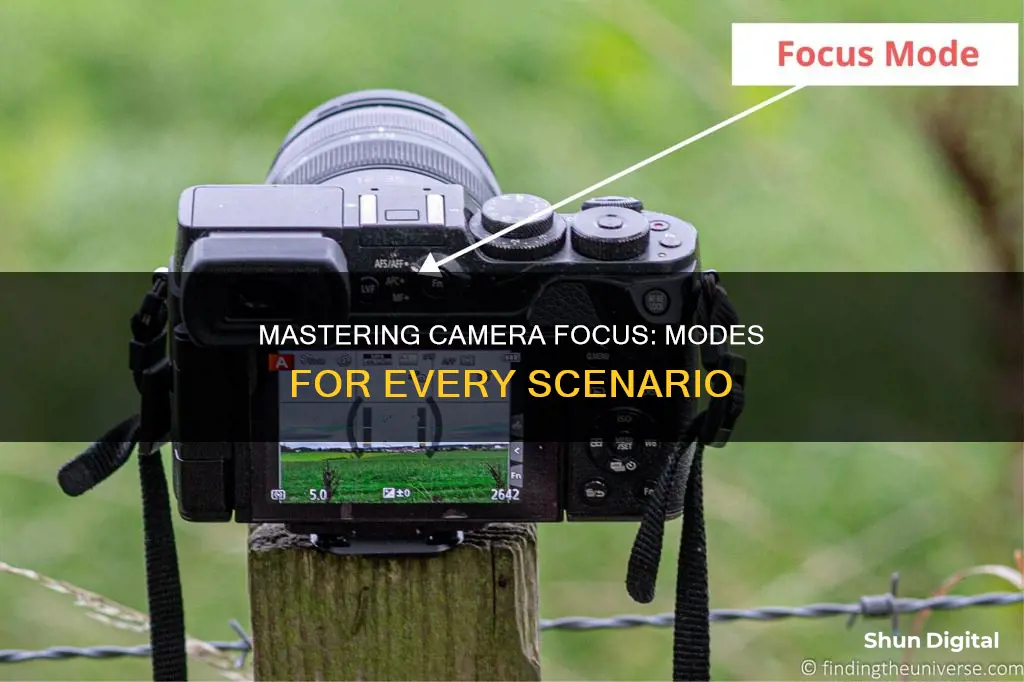
Choosing the right focus mode for your camera is essential to getting a sharp image. There are two main types of focus modes: autofocus and manual focus. Autofocus modes include single autofocus, continuous autofocus, and hybrid autofocus. Single autofocus is best for stationary subjects, while continuous autofocus is ideal for moving subjects. Hybrid autofocus combines the benefits of both single and continuous autofocus. On the other hand, manual focus gives you full control over the focus and is preferred in low-light conditions or when you want creative compositions. Different camera brands may use different names for these focus modes, but the underlying concepts remain the same.
| Characteristics | Values |
|---|---|
| Number of Focus Modes | 2 |
| Focus Modes | Manual, Autofocus |
| Autofocus Modes | Single, Continuous, Hybrid |
| Manual Focus Mode (MF) | Adjust the lens ring to set the focus distance |
| Autofocus Mode (AF) | Camera automatically determines what's in focus |
| Autofocus Single Mode (AF-S) | Designed for stationary subjects |
| Autofocus Continuous Mode (AF-C) | Designed for moving subjects |
| Autofocus Hybrid Mode (AF-A) | Switches between single and continuous modes |
| Autofocus Area Modes | Single-Point, Dynamic Area, Auto Area, 3D Tracking |
| Single-Point Area Mode | Choose a specific focus point in the frame |
| Dynamic Area Mode | Choose a focus point, but the camera can adjust when the subject moves |
| Auto Area Mode | Camera finds the subject and chooses a focus point |
| 3D Tracking Mode | Camera focuses on the subject even if the scene is recomposed |
What You'll Learn

Manual focus mode
To use manual focus mode, you need to locate the focusing mode switch on your camera or lens, which is usually labelled AF/MF. Once you have located this, you can switch your setup to MF. You can then use the focus ring on your lens to adjust the focus. This is usually located in the middle of the lens barrel for prime lenses, and near the end of the lens barrel for zoom lenses.
As you turn the focus ring, you will see different parts of the image come into focus. The point at which an object comes into focus correlates with its distance from the lens. You can see the distance in feet or metres displayed on the top of the lens.
Overall, while manual focus mode may take some time to get used to, it gives photographers more control over their images and can help to achieve certain effects that are not possible with autofocus.
Camera Battery Leak: What You Need to Know
You may want to see also

Autofocus single
When you half-press the shutter button, the autofocus system will focus on the subject. Once focus is achieved, it will be locked, and you can take the picture. If you move the camera or the subject moves, the focus will not adjust, and you will need to focus again.
AF-S is a good choice when you need to ensure that the focus remains locked on a specific part of the scene or subject. It is also useful when shooting in low-light conditions or when there is very little contrast in the scene, as it allows you to set the focus accurately.
It is important to note that different camera brands may use different terms for the same autofocus mode. For example, Nikon refers to this mode as AF-S, while Canon calls it One-Shot AF, and Sony labels it as Single-Shot AF.
Mastering the Art of Hiding Pins in Camera Raw Adjustment Brush
You may want to see also

Autofocus continuous
AF-C is available on most modern digital cameras and is particularly useful when the subject moves around during the shoot. For example, if you are into event, wildlife, or sports photography, AF-C helps you control the tracking of subjects and refocusing accordingly.
AF-C is also an excellent choice for wildlife photography and casual outings with family and friends. It is a basic camera control option, and learning how to use it will improve your photography in general, as well as in specific situations.
To set up AF-C on your camera, you can usually find it by accessing the focus mode settings from your camera's menu and selecting the mode you want to use. Alternatively, you can use a switch or button on your camera body or lens to toggle between AF and CF modes.
When using AF-C, the camera will continue to focus while the shutter button is pressed and held halfway down. This allows you to capture sharp images of moving subjects without having to constantly adjust the focus manually.
AF-C is particularly useful when you want to capture a subject in motion and don't want to miss the shot by adjusting the focus manually. It is important to note that different camera manufacturers use different names for this mode, such as AI Servo AF for Canon and AF-C for Nikon.
AF-C has some limitations, such as predicting the movement of a bird or a cheetah chasing prey. To address these limitations, camera manufacturers have developed variations of continuous focus modes, such as Animal Eye AF, Vehicle AF, and Deep Learning AF.
When using AF-C, it is also important to consider the drawbacks, such as increased battery usage and the camera's inability to always predict the subject's movement correctly. Additionally, the speed and accuracy of the camera's focus depend on the lens being used.
Overall, AF-C is a valuable tool for photographers who want to capture clear and sharp images of moving subjects without constantly adjusting the focus manually.
Understanding Camera Raw's Unique Circular Slider
You may want to see also

Autofocus hybrid
Autofocus (AF) systems have become an integral part of production workflows, thanks to their speed, reliability, and precision. The AF system uses a sensor, a control system, and a motor to focus on a selected point or area automatically or manually. There are different types of AF systems, including active, passive, and hybrid types.
A hybrid AF system combines two autofocus technologies: contrast detection and phase detection. In a hybrid system, phase detection is used first, followed by contrast detection. These two mechanisms complement each other. Phase detection allows the camera to know which direction to move to achieve the best focus, while contrast detection helps to identify the sharpest focus. However, to determine the sharpest image, the camera must move past the sharpest point and then return to it, a process known as "hunting."
The Sony A6000 is a notable example of a camera with a hybrid AF system, boasting a lag time of just 0.06 seconds, making it the world's fastest AF system at the time of its release. Sony's Fast Hybrid AF system combines phase detection autofocus technology with contrast detection autofocus, enabling it to deliver sharp images even in low-light conditions.
The advantages of a hybrid AF system include accuracy and speed. By using phase detection initially, the camera can quickly move towards the optimal focus point, and then fine-tune it using contrast detection. This two-step process makes the hybrid AF system superior to using either method alone.
In conclusion, the hybrid autofocus system offers a powerful combination of speed and precision, making it a reliable choice for photographers and videographers. Its ability to deliver sharp images in various lighting conditions makes it a versatile tool for capturing fast-moving subjects and achieving consistently focused shots.
Charging Your USB Spy Camera: A Quick Guide
You may want to see also

Autofocus area selection modes
Single-Point AF Area Mode
Single-Point AF Area Mode is a versatile option that allows you to select a single focus point within your frame. This mode is available on both basic and advanced camera models, with the latter offering more focus points for better precision. It is ideal for still subjects or scenes where precise focus is required, such as landscape and portrait photography.
Dynamic AF Area Mode
Dynamic AF Area Mode is perfect for capturing moving subjects. Once you've manually selected your initial focus point, this mode uses the surrounding focus points to keep your subject in focus, even if they move. You can adjust the size of the dynamic area based on your needs, with options like 9, 21, or 51 points. This mode is excellent for wildlife and sports photography, where subjects are constantly in motion.
Group AF Area Mode
Group AF Area Mode is a fantastic choice when you want to focus on a specific area or zone within your frame. It allows you to select a small group of autofocus points to ensure accurate focusing. This mode is useful for wildlife, sports, and portrait photography when you want to capture a group of subjects in a particular area.
Auto AF Area Mode
Auto AF Area Mode is a fully automatic mode that lets the camera decide which focus points to use. It relies on various factors, such as subject distance, motion, and the presence of detectable eyes, to determine the area of focus. While this mode is excellent for beginners, it may not be ideal when you need more control over your focus point selection.
Pinpoint AF Mode
Pinpoint AF Mode is a specific mode available on some camera models, such as Nikon. It utilizes Contrast Detection AF to achieve precise focus on a very small portion of the scene. This mode is perfect for stationary subjects like landscapes, architecture, product photography, and macro shots.
3D Tracking Mode
3D Tracking Mode is an advanced autofocus area mode that uses colour recognition to track and focus on moving subjects. It activates all available focus points and adjusts them as needed to keep the subject in focus. This mode is excellent for capturing fast-moving subjects like birds or wildlife but may struggle with busy backgrounds.
GoPro Cameras: Which Models Offer the Longest Battery Life?
You may want to see also
Frequently asked questions
AF-S locks focus once it’s achieved, making it great for stationary subjects. AF-C, on the other hand, continuously adjusts focus, making it ideal for moving subjects.
Manual Focus Mode is when you adjust the focus of your camera lens manually by turning the focus ring until your subject is sharp. This can be useful in low-light situations or when your camera struggles to focus automatically.
AF-S and Single-Point AF area mode are the best focus modes for landscape photography as they allow you to lock focus on a static subject.
AF-C is the best focus mode for moving subjects as it will continuously track and refocus on your subject.
Continuous Eye AF is the best focus mode for portraits as it ensures the eyes of your subjects remain in sharp focus.







